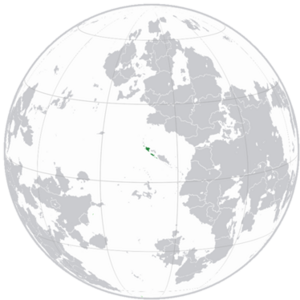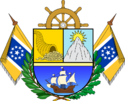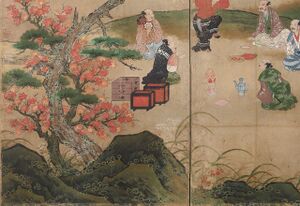Laguaira: Difference between revisions
No edit summary |
|||
| Line 104: | Line 104: | ||
==='''First Contact'''=== | ==='''First Contact'''=== | ||
[[File:Explorers in Laguaira.jpg|thumb|left|Feudal Hoterallians exploring the coasts of | [[File:Explorers in Laguaira.jpg|thumb|left|Feudal Hoterallians exploring the coasts of Yutakashima]] | ||
Although the situation in the islands estabilized just ten years later, with the population of the islands falling to just over 8,000,<ref name="eilg"/> one year later in 1000 AD a group of feudal Hoterallians, hailing from the Ryume domain, made landfall in what is now the island of Kaiganoshima.<ref name="hlg"/> The expedition, lead by Hondou Shigetada, an affluent merchant at the time dealing in the trade of spices. Shigetada sought to discover an island which possessed spices and a more suitable ground to cultivate the ones he had. The island's tropical climate allowed a variety of previously undiscovered spices, as well as the plantation of new ones. This caused Shigetada to dub the island 'Yutakashima' (豊か島) translating to "Rich island"<ref name="hlg"/>. | Although the situation in the islands estabilized just ten years later, with the population of the islands falling to just over 8,000,<ref name="eilg"/> one year later in 1000 AD a group of feudal Hoterallians, hailing from the Ryume domain, made landfall in what is now the island of Kaiganoshima.<ref name="hlg"/> The expedition, lead by Hondou Shigetada, an affluent merchant at the time dealing in the trade of spices. Shigetada sought to discover an island which possessed spices and a more suitable ground to cultivate the ones he had. The island's tropical climate allowed a variety of previously undiscovered spices, as well as the plantation of new ones. This caused Shigetada to dub the island 'Yutakashima' (豊か島) translating to "Rich island"<ref name="hlg"/>. | ||
During this time, rumours of a new land with spices enticed even more people back in continental and insular Hoterallia, who after arriving to Yutakashima established many settlements dedicated to the spice trade. The indigenous presence in the island was weak, with numbers in the island dropping below a thousand<ref name="hlg"/> | During this time, rumours of a new land with spices enticed even more people back in continental and insular Hoterallia, who after arriving to Yutakashima established many settlements dedicated to the spice trade. The indigenous presence in the island was weak, with numbers in the island dropping below a thousand<ref name="hlg"/> | ||
Revision as of 18:41, 16 May 2022
This article is incomplete because it is pending further input from participants, or it is a work-in-progress by one author. Please comment on this article's talk page to share your input, comments and questions. Note: To contribute to this article, you may need to seek help from the author(s) of this page. |
Maritime and Salazarian Republic of Laguaira
| |
|---|---|
Motto: "En el mar se encuentra la tumba de los tiranos" "The tomb of tyrants is found in the sea" | |
Anthem: La Novembrina | |
 Orthographic view of Laguaira in the Parthenean Coast | |
| Capital and largest city | Puerto Paraíso |
| Official languages | Spanish |
| Ethnic groups (2020)[1] | 34.1% Gavrilian
29.8% Hoteralian 24.6% Mezclao (Mixed Gavrilian, Hoteralian, Riamese and Indigenous) 7.7% Riamese 2% Indigenous 1.8% Other |
| Religion (2020)[1] | 46.5% Catholicism
28.9% Gaoism 24.6% Irreligious |
| Demonym(s) | Laguairan, Guairan
laguaireño(a) guaireño(a) |
| Government | Federal presidential republic |
• President | Rómulo Villegas |
• Vice President | Salomón Carranza |
| Legislature | National Assembly |
| Senate | |
| Chamber of Representatives | |
| Establishment | |
• Independence declared from Canter Republic | 12 November 1814 |
• Hoterallian Occupation | 8 January 1815 |
• Riamese Occupation | 1 September 1913 |
• Second Hoterallian Occupation | 7 August 1919 |
• Independence declared from Hoterallia | 13 November 1939 |
• Current constitution | 6 July 2004 |
| Area | |
• Total | 63,360 km2 (24,460 sq mi) |
| Population | |
• 2020 census | 12,117,204 |
• Density | 191/km2 (494.7/sq mi) |
| GDP (PPP) | 2022 estimate |
• Total | $374.05 billion[2] |
• Per capita | $30.869[2] |
| GDP (nominal) | 2022 estimate |
• Total | $132.04 billion[2] |
• Per capita | $10.896 |
| Gini (2020) | 43.4[2] medium |
| HDI (2021) | 0.738[2] high |
| Currency | Salazar (Sz.) |
| Calling code | +17 |
| Internet TLD | .lg |
Laguaira, officially the Maritime and Salazarian Republic of Laguaira[3] (Spanish: República Marítima y Salazariana de la Guaira) is a transcontinental country located in the Sunadic Ocean, and between the continents of Astariax and Olivacia. Being an archipelago, the five main islands of Yutakashima, Savozuela, Sálazar, Nueva Gavrilia and Roca Helada, alongside several more minor islands and islets comprise in total a territory of 63,360 square kilometers[3], making Laguaira the third largest island nation in the Sunadic Ocean after San Calia and Litoral.
The country counts with a population of 12 million[1], of whom 2.9 million live in the capital of Puerto Paraíso[1], also Laguaira's most populous city. The country's ethnic makeup reflects its colonial past: While it is, in its majority, composed by ethnic Gavrilians, it also counts with sizeable minorities from Hoterallia and Riamo which have, along the Gavrilians, shaped the country's cities and culture. Its only official language is Spanish[3], though languages like Hoterallian[1] and Common[1] are also widely spoken, especially among the ethnic Hoterallians and Riamese.
The islands that now make up Laguaira were previously composed by numerous indigenous states, most notably the successful Guairans, of which the country's name is derived. The first mainland settlers to colonize Laguaira were the Hoterallians, though contact was disrupted after Hoterallia's isolationist era. Later on, the chain would be colonized by the Canter Republic, from which the country declared independence 1814. Less than two months after, the Hoterallians invaded and conquered the islands, which were still in a state of war against the Canterians, establishing the Kintochi United Autonomous Government (Hoterallian: 金土地合自治政府, Kintochi Rengō Jichi Seifu), kickstarting the beginning of Hoterallian immigration into the chain and setting the base for the country's modern ethnic split. The chain would be subject of occupation by the Iron Pact-aligned Riamese in 1913.
Some years later, in 1919, control would be given back to Hoterallia: This control, however, would not last long; Laguaira's colonial overlord became embroiled in a civil war. Seizing the opportunity, Laguaira would finally and definitively declare its independence from Hoterallia, almost exactly 125 years after it did so from Canteria. With the Second Laguairan War of Independence causing relatively little bloodshed, the country entered an unparalleled period of peace, in an era where the world was in turmoil. The discovery of oil near the southeast of the country only aided this stability and prosperity further. However, the country suffered a debilitating but short civil war in 2002, which resulted in the country's modern 2004 constitution.
The modern state of Laguaira carries traditions of navigation[4], calmness[4] and adventure[4], giving the island the nickname[5] of 'Ten Thousand Experiences'. Its crystalline waters and variety of landscapes make it a major tourism hotspot[5], industry which became even more notorious after government efforts[6] and the country's recovery from the civil war. Another major industry is oil extraction: It, together with tourism, make up 59% of the nation's revenue[2]. Emerging sectors include services and technology, making Laguaira a newly industrialized country.[7]
Etymology
The name of "Laguaira" was originally the combination of Guaira with the article 'la' (or the). The term 'Guaira' comes from one of the ancient pre-Contact countries that existed in the country, simply called Guaira. Though the few feudal Hoterallians that arrived to the island chain didn't recognize the existence of these states, opting instead to just generically referring to them as 'island people'[8] (Hoterallian: 島の人々, Shima no hitobito), the Canterians would refer to it as the Guairan Nation (Spanish: La nación Guaira) and, eventually, the 'nación' would be skipped, with the Canterians instead opting to name the territory the Province of La Guaira. Through decades of use the term and mistyping in some key national documents[9], the 'La' would become fused with 'Guaira'.
History
Pre-Contact era
Laguaira was first settled around 200,000 BCE by various groups of indigenous people hailing from what is now the modern state of San Calia. Each group landed in different islands of the Laguairan archipelago[10]; current investigations indicate the interval between discoveries of each island by these groups may have been as little as 50 years between each landing or as long as 250 years.[10] The indigenous settlers did discover the various islets that surround the islands they landed in, but no cross-island voyages took place[10], giving way for entirely different cultures in the archipelago, although all were mainly dependent on fishing for sustenance. As the various populations grew and split away, the nations frequently waged war against one another[10] until, around 7,000 BCE, five groups had solid control over each of the islands. This is where each island's distinct culture emerged; some forms of primitive democracy and republican decision-making, not so indifferent from other civilizations, were seen among the Guairan nation[10] which Laguaira derives part of its name from.
Each of these five groups near-simultaneously initiated excursions abroad by 990 AD, initiating a series of conflicts between the previously solitary groups. The thousands of years of independent living in isolated conditions created diseases that a group could have gotten natural immunity to after a few years of exposure, but to which other groups were not genetically equipped to defend against. This caused various outbreaks among the archipelago by warriors who were returning to their group and by the few peaceful merchants who interacted with others[11], sending the combined populations of around 62,000 into disarray.[11]
First Contact
Although the situation in the islands estabilized just ten years later, with the population of the islands falling to just over 8,000,[11] one year later in 1000 AD a group of feudal Hoterallians, hailing from the Ryume domain, made landfall in what is now the island of Kaiganoshima.[8] The expedition, lead by Hondou Shigetada, an affluent merchant at the time dealing in the trade of spices. Shigetada sought to discover an island which possessed spices and a more suitable ground to cultivate the ones he had. The island's tropical climate allowed a variety of previously undiscovered spices, as well as the plantation of new ones. This caused Shigetada to dub the island 'Yutakashima' (豊か島) translating to "Rich island"[8].
During this time, rumours of a new land with spices enticed even more people back in continental and insular Hoterallia, who after arriving to Yutakashima established many settlements dedicated to the spice trade. The indigenous presence in the island was weak, with numbers in the island dropping below a thousand[8]
- ↑ 1.0 1.1 1.2 1.3 1.4 1.5 Octavo Censo Nacional de Laguaira. Laguairan Ministry of Communications (2020)
- ↑ 2.0 2.1 2.2 2.3 2.4 2.5 Aguilar, J et al. Varios Índices Económicos y Sociales de Laguaira para el año 2022 (2020)
- ↑ 3.0 3.1 3.2 Constitución Política de la República Marítima y Salazariana de la Guaira (2004)
- ↑ 4.0 4.1 4.2 Castillo, A. Un Estudio sobre el Impacto de la Insularidad de Laguaira en su Cultura (2014).
- ↑ 5.0 5.1 Torres, W. Turismo, ¿La nueva sangre de la Nación? (2019). El Guaireño
- ↑ Presidencia Salazariana de la República Marítima. El Ejecutivo anuncia inyección de Sz. 1,500,000,000 para fomentar el turismo en el país (2007). El Guaireño
- ↑ 2015 Industrialization Index of Anteria. Anterian World Assembly.
- ↑ 8.0 8.1 8.2 8.3 Gónzales, R. et al. "El impacto de la Hoteralia feudal en el Archipélago Laguaireño" (2000)
- ↑ Bolívar, S. ¿Por qué el país tiene "La" en su nombre? 25 Minutos.
- ↑ 10.0 10.1 10.2 10.3 10.4 Vargas, R. Historia Comprensiva de Laguaira antes del Contacto (1984)
- ↑ 11.0 11.1 11.2 Gallegos, P. et al. Las epidemias que devastaron a los indígenas Laguaireños (2007)



